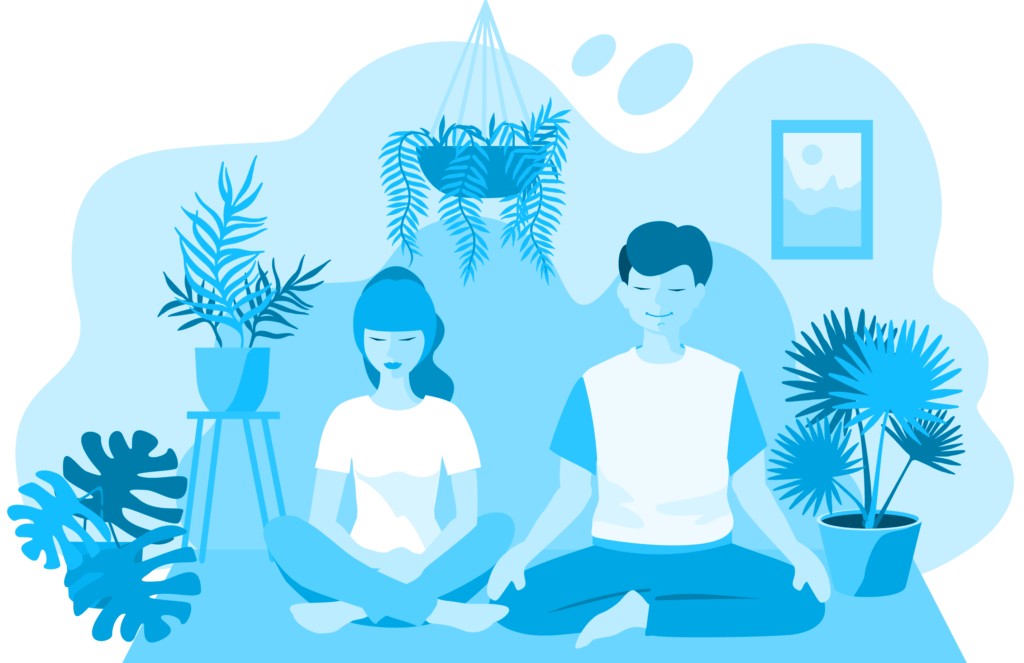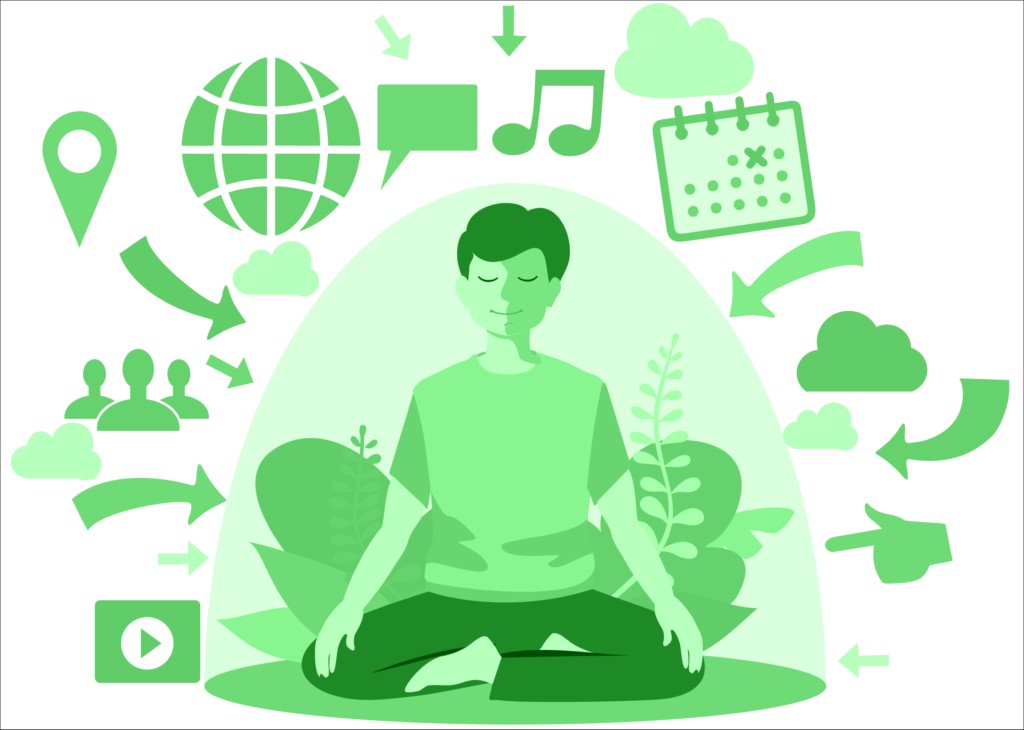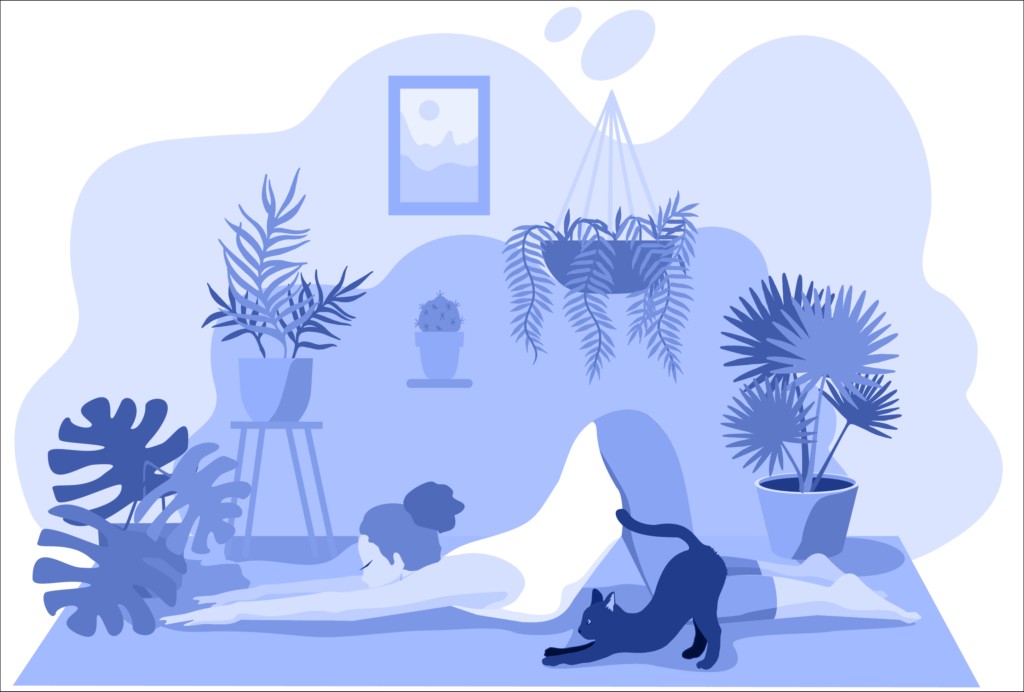Learning How Do I Learn To Meditate opens doors to inner peace and enhanced well-being, and it’s a journey worth embarking on. At LEARNS.EDU.VN, we offer a clear path to mastering meditation, helping you unlock its profound benefits. Discover relaxation techniques, mindfulness exercises, and inner peace strategies to transform your life.
1. Understanding the Essence of Meditation
Meditation is a transformative practice that cultivates a state of mental clarity and emotional tranquility. To fully grasp what meditation entails, think of it as a disciplined approach to training your mind, much like physical exercise trains your body. It’s a process of gently guiding your thoughts, emotions, and sensations to a focused point, often the breath, which acts as an anchor in the present moment.
Defining meditation more comprehensively, it’s a technique that enhances mindfulness and awareness. By consistently practicing meditation, individuals can improve their concentration, reduce stress, and foster a deeper sense of self-awareness. This practice allows you to observe your thoughts and feelings without judgment, leading to greater emotional regulation and mental well-being.
1.1. The Core Principles of Meditation
Meditation revolves around several key principles. Understanding these principles is crucial for anyone starting their meditation journey.
- Mindfulness: Being fully present in the current moment without judgment.
- Concentration: Focusing the mind on a single point, such as breath, a mantra, or a visual image.
- Awareness: Observing thoughts and emotions as they arise without getting carried away by them.
- Acceptance: Acknowledging and accepting thoughts and feelings without resistance.
- Non-judgment: Observing thoughts and feelings without labeling them as good or bad.
1.2. Meditation vs. Mindfulness
While the terms meditation and mindfulness are often used interchangeably, they represent distinct yet interconnected concepts. Meditation is a practice, while mindfulness is a quality of being. Meditation techniques are employed to cultivate mindfulness, enhancing the ability to be present and aware in daily life.
Consider meditation as the training ground where you develop the skill of mindfulness. Through regular meditation, you become more attuned to your thoughts, feelings, and sensations. This heightened awareness allows you to respond to life’s challenges with greater clarity and equanimity, rather than reacting impulsively. Mindfulness extends beyond formal meditation sessions, influencing how you approach interactions, tasks, and experiences throughout your day.
1.3. Historical and Cultural Roots
Meditation has ancient roots, tracing back thousands of years across various cultures and spiritual traditions. Originating in Eastern philosophies, particularly Hinduism and Buddhism, meditation served as a pathway to spiritual enlightenment and self-discovery. These practices were integral to monastic life and spiritual development, emphasizing inner peace and understanding.
Over time, meditation spread beyond its religious origins, evolving into secular forms that focus on mental health and personal well-being. Today, mindfulness-based stress reduction (MBSR) and other meditation techniques are widely used in therapeutic settings, corporate wellness programs, and educational institutions. This evolution reflects meditation’s universal appeal and adaptability as a tool for enhancing mental and emotional resilience.
1.4. Debunking Common Misconceptions
Many misconceptions surround meditation, which can deter individuals from exploring its benefits. One common myth is that meditation requires emptying the mind completely. In reality, meditation involves observing thoughts without attachment, allowing them to pass without judgment.
Another misconception is that meditation is exclusively for spiritual or religious purposes. While meditation can be part of a spiritual practice, it is also a secular tool for stress reduction, improved focus, and enhanced emotional well-being. Additionally, some believe meditation is difficult or time-consuming, but even short sessions of five to ten minutes can yield significant benefits. Clearing up these misconceptions makes meditation more accessible and appealing to a broader audience.
2. Unveiling the Multifaceted Benefits of Meditation
Meditation offers a plethora of benefits that extend beyond mere relaxation. These advantages impact physical, mental, and emotional health, fostering a more balanced and fulfilling life.
2.1. Stress Reduction and Emotional Well-being
Meditation is renowned for its ability to reduce stress and promote emotional well-being. Regular practice helps lower cortisol levels, the hormone associated with stress, and activates the parasympathetic nervous system, which promotes relaxation. By reducing stress, meditation can alleviate symptoms of anxiety and depression, fostering a sense of calm and emotional stability.
A study published in the Journal of the American Medical Association (JAMA) found that mindfulness meditation can significantly reduce symptoms of anxiety and depression. The research highlighted that consistent meditation practice led to noticeable improvements in mood and overall mental health.
2.2. Enhanced Focus and Cognitive Function
Meditation enhances focus and cognitive function by training the mind to concentrate and resist distractions. Regular meditation strengthens the brain’s prefrontal cortex, the area responsible for attention and decision-making. This leads to improved concentration, memory, and overall cognitive performance.
Research from the University of California, Los Angeles (UCLA) demonstrated that long-term meditators have increased gray matter in brain regions associated with attention and emotional regulation. The study suggests that meditation can lead to structural changes in the brain, enhancing cognitive abilities over time.
2.3. Improved Physical Health
Meditation’s benefits extend to physical health, including reduced blood pressure, improved sleep quality, and enhanced immune function. By lowering stress levels, meditation helps reduce the risk of cardiovascular diseases. Improved sleep results from a calmer mind, making it easier to fall asleep and stay asleep. Additionally, meditation can boost the immune system by decreasing inflammation and promoting overall well-being.
A study published in the journal Psychosomatic Medicine found that mindfulness meditation can lower blood pressure and reduce the risk of heart disease. The research indicated that regular meditation practice had a similar effect on blood pressure as some medications.
2.4. Pain Management
Meditation can be an effective tool for pain management by helping individuals change their perception of pain. By focusing on the present moment and practicing acceptance, individuals can reduce their emotional reaction to pain, making it more manageable. Meditation can also release endorphins, natural pain relievers that can alleviate discomfort.
Research from the University of Massachusetts Medical School showed that mindfulness-based stress reduction (MBSR) can significantly reduce chronic pain. The study revealed that participants who completed the MBSR program reported lower levels of pain and improved quality of life.
2.5. Increased Self-Awareness
Meditation cultivates self-awareness by encouraging individuals to observe their thoughts and emotions without judgment. This practice allows for a deeper understanding of one’s patterns of thinking, feeling, and behaving. Increased self-awareness fosters better decision-making, improved relationships, and a greater sense of personal authenticity.
A study in the journal Mindfulness found that regular meditation practice enhances self-compassion and reduces self-criticism. The research highlighted that individuals who meditated regularly were more accepting and kind towards themselves, leading to improved mental and emotional well-being.
2.6. Cultivating Compassion and Empathy
Meditation practices, such as loving-kindness meditation, can cultivate compassion and empathy by promoting feelings of warmth and connection towards oneself and others. These practices help individuals develop a greater sense of empathy, fostering improved relationships and a more compassionate outlook on life.
Research from Stanford University demonstrated that loving-kindness meditation can increase feelings of social connection and positivity towards others. The study showed that participants who practiced loving-kindness meditation reported higher levels of empathy and compassion compared to those who did not meditate.
3. Setting the Stage: Preparing for Meditation
Preparing your environment and mindset is crucial for a successful meditation practice.
3.1. Creating a Conducive Environment
Your meditation space should be calm, quiet, and free from distractions. Choose a location where you feel comfortable and safe.
- Find a Quiet Space: Select a room or corner in your home where you can minimize noise and interruptions.
- Optimize Lighting: Soft, natural light is ideal. Avoid harsh or fluorescent lighting that can be distracting.
- Temperature Control: Ensure the room is at a comfortable temperature, neither too hot nor too cold.
- Minimize Clutter: Keep your meditation space clean and organized to reduce visual distractions.
- Use Calming Elements: Incorporate elements that promote relaxation, such as plants, candles, or soft music.
3.2. Choosing the Right Time
The best time to meditate varies from person to person. Experiment with different times to find what works best for you.
- Morning Meditation: Many find that meditating in the morning sets a positive tone for the day, improving focus and reducing stress.
- Evening Meditation: Meditating in the evening can help you unwind and prepare for a restful night’s sleep.
- Midday Meditation: A short meditation break during the day can help you recharge and refocus, especially during stressful periods.
- Consistency is Key: Regardless of the time you choose, aim for consistency to establish a regular meditation practice.
3.3. Setting Intentions
Setting intentions before you meditate can help focus your mind and align your practice with your goals.
- Reflect on Your Goals: Consider what you hope to achieve through meditation, such as reducing stress, improving focus, or cultivating compassion.
- Formulate a Clear Intention: State your intention clearly and positively, such as “I intend to cultivate inner peace” or “I intend to be more present.”
- Visualize Your Intention: Take a moment to visualize your intention, imagining the positive outcomes you seek.
- Reiterate Your Intention: Repeat your intention silently to reinforce it in your mind before you begin your meditation practice.
3.4. Dressing Comfortably
Wearing comfortable, loose-fitting clothing can help you relax and focus during meditation.
- Choose Soft Fabrics: Opt for clothing made from soft, breathable fabrics like cotton or linen.
- Avoid Restrictive Clothing: Steer clear of tight waistbands, collars, or cuffs that can restrict movement and cause discomfort.
- Dress in Layers: Dressing in layers allows you to adjust your clothing to maintain a comfortable temperature throughout your meditation session.
- Remove Accessories: Take off any jewelry, watches, or belts that may cause distractions or discomfort.
3.5. Preparing Your Body
Preparing your body before meditation can enhance your comfort and ability to relax.
- Gentle Stretching: Perform gentle stretches to release tension in your muscles, especially in your neck, shoulders, and back.
- Hydration: Drink a glass of water before meditating to stay hydrated and comfortable.
- Avoid Heavy Meals: Avoid eating heavy meals before meditating, as digestion can be distracting.
- Use the Restroom: Ensure you have used the restroom before starting your meditation to avoid interruptions.
4. Step-by-Step Guide: How to Meditate
Learning how to meditate can be a simple yet profound process. Follow these steps to begin your meditation journey.
4.1. Finding a Comfortable Position
Start by finding a comfortable position. You can sit on a cushion, chair, or even lie down.
- Sitting on a Cushion: Sit cross-legged on a cushion with your hips slightly elevated. This helps maintain a straight spine.
- Sitting on a Chair: Sit upright in a chair with your feet flat on the floor. Ensure your back is straight but not stiff.
- Lying Down: Lie on your back with your arms at your sides and your legs slightly apart. This position is best for relaxation but may lead to drowsiness.
- Maintaining Posture: Regardless of the position you choose, keep your spine straight, shoulders relaxed, and chin slightly tucked.
4.2. Focusing on Your Breath
Once you are comfortable, turn your attention to your breath.
- Notice the Sensation: Pay attention to the sensation of your breath as it enters and exits your body.
- Follow the Breath: Follow the breath from the tip of your nose to your lungs and back again.
- Natural Breathing: Breathe naturally without trying to control or change your breath.
- Use a Mantra: If focusing on your breath is difficult, try using a mantra, a word or phrase repeated silently with each breath.
4.3. Dealing with Wandering Thoughts
It is normal for your mind to wander during meditation.
- Acknowledge the Thought: When you notice your mind wandering, acknowledge the thought without judgment.
- Let Go of the Thought: Gently release the thought and redirect your attention back to your breath.
- Be Kind to Yourself: Avoid criticizing yourself for having wandering thoughts. It is a natural part of the process.
- Return to the Breath: Each time your mind wanders, gently guide your attention back to your breath.
4.4. Practicing Regularly
Consistency is key to experiencing the benefits of meditation.
- Start Small: Begin with short meditation sessions of 5 to 10 minutes and gradually increase the duration as you become more comfortable.
- Set a Schedule: Schedule a specific time each day for meditation to make it a regular habit.
- Use Reminders: Set reminders on your phone or computer to prompt you to meditate.
- Be Patient: It takes time to develop a consistent meditation practice. Be patient with yourself and celebrate your progress.
4.5. Ending Your Meditation
End your meditation session gently.
- Gradually Return: Slowly bring your awareness back to your surroundings.
- Notice Your Body: Take a moment to notice how your body feels.
- Reflect on Your Experience: Reflect on your meditation experience, noting any insights or sensations.
- Carry the Calm: Carry the sense of calm and focus from your meditation into your daily activities.
5. Exploring Different Meditation Techniques
There are various meditation techniques, each with its unique approach and benefits.
5.1. Mindfulness Meditation
Mindfulness meditation involves paying attention to the present moment without judgment.
- Focus on the Present: Focus on your breath, body sensations, or sounds in your environment.
- Observe Thoughts: Observe your thoughts and emotions as they arise without getting carried away by them.
- Non-Judgmental Awareness: Practice non-judgmental awareness, accepting thoughts and feelings without labeling them as good or bad.
- Regular Practice: Regular mindfulness meditation can improve focus, reduce stress, and increase self-awareness.
5.2. Samatha-Vipassana Meditation
Samatha-Vipassana meditation combines two key practices.
- Samatha (Calm Abiding): This involves focusing on a single object, such as the breath, to calm and stabilize the mind.
- Vipassana (Insight): Once the mind is calm, Vipassana involves observing the changing nature of thoughts, feelings, and sensations to gain insight into the nature of reality.
- Combined Practice: By combining Samatha and Vipassana, practitioners can develop both mental clarity and profound insights.
5.3. Walking Meditation
Walking meditation involves bringing mindfulness to the act of walking.
- Natural Pace: Walk at a natural pace, paying attention to the sensation of your feet making contact with the ground.
- Focus on Movement: Focus on the movement of your legs and the shifting of your body.
- Awareness of Surroundings: Maintain awareness of your surroundings while staying focused on the sensation of walking.
- Mindful Movement: Walking meditation can be practiced indoors or outdoors, providing a way to integrate mindfulness into your daily activities.
5.4. Body Scan Meditation
Body scan meditation involves bringing awareness to different parts of your body.
- Start with Your Toes: Begin by focusing your attention on your toes, noticing any sensations.
- Move Upward: Gradually move your attention up your body, focusing on each body part in sequence.
- Notice Sensations: Notice any sensations, such as tingling, warmth, or tension.
- Non-Judgmental Observation: Observe these sensations without judgment, simply noting what you feel.
5.5. Loving-Kindness Meditation (Metta)
Loving-kindness meditation involves cultivating feelings of love and compassion towards oneself and others.
- Start with Yourself: Begin by directing feelings of love and compassion towards yourself, repeating phrases such as “May I be happy, may I be healthy, may I be safe, may I live with ease.”
- Extend to Others: Gradually extend these feelings to loved ones, friends, neutral individuals, difficult individuals, and eventually all beings.
- Repeat Phrases: Repeat phrases of loving-kindness silently, focusing on the feelings of warmth and connection that arise.
- Cultivate Compassion: Loving-kindness meditation can cultivate compassion, empathy, and a greater sense of interconnectedness.
6. Common Challenges and How to Overcome Them
Meditating can present challenges, but with the right strategies, they can be overcome.
6.1. Restlessness and Impatience
Restlessness and impatience are common challenges in meditation.
- Acknowledge the Feeling: Acknowledge the feeling of restlessness without judgment.
- Shift Your Focus: Gently shift your focus back to your breath or chosen object of attention.
- Shorten Your Sessions: If you are feeling particularly restless, shorten your meditation session.
- Practice Acceptance: Practice acceptance, recognizing that restlessness is a temporary state.
6.2. Sleepiness
Sleepiness can be a challenge, especially during long meditation sessions.
- Adjust Your Posture: Sit upright in a chair or on a cushion to help stay awake.
- Meditate at a Different Time: Try meditating at a time when you are more alert.
- Use a Stimulating Technique: Use a stimulating meditation technique, such as focusing on a bright light or walking meditation.
- Get Enough Sleep: Ensure you are getting enough sleep to reduce daytime drowsiness.
6.3. Skepticism and Doubt
Skepticism and doubt can hinder your meditation practice.
- Educate Yourself: Learn more about the benefits of meditation to dispel skepticism.
- Try It Yourself: Experience meditation firsthand to see if it works for you.
- Start Small: Begin with short meditation sessions and gradually increase the duration.
- Be Open-Minded: Approach meditation with an open mind, willing to explore its potential benefits.
6.4. Pain and Discomfort
Pain and discomfort can make it difficult to meditate.
- Adjust Your Position: Find a comfortable position that minimizes pain and discomfort.
- Use Props: Use cushions, blankets, or chairs to support your body and reduce strain.
- Practice Body Scan Meditation: Use body scan meditation to bring awareness to areas of pain and discomfort.
- Consult a Healthcare Professional: If you have chronic pain, consult a healthcare professional for guidance.
6.5. Emotional Overwhelm
Meditation can sometimes bring up difficult emotions.
- Acknowledge the Emotion: Acknowledge the emotion without judgment.
- Create Space: Create space for the emotion, allowing it to be present without getting carried away by it.
- Practice Self-Compassion: Practice self-compassion, treating yourself with kindness and understanding.
- Seek Support: If you are feeling overwhelmed, seek support from a therapist or counselor.
7. Integrating Meditation into Daily Life
Integrating meditation into your daily life can enhance its benefits and make it a sustainable practice.
7.1. Mindful Moments
Incorporate mindful moments throughout your day.
- Mindful Breathing: Take a few mindful breaths before starting a task or during stressful moments.
- Mindful Eating: Pay attention to the taste, texture, and smell of your food while eating.
- Mindful Walking: Walk with awareness, noticing the sensation of your feet making contact with the ground.
- Mindful Listening: Listen attentively to others without interrupting or judging.
7.2. Using Technology
Utilize technology to support your meditation practice.
- Meditation Apps: Use meditation apps to guide your practice and track your progress.
- Online Communities: Join online communities to connect with other meditators and share experiences.
- Reminder Tools: Use reminder tools to prompt you to meditate throughout the day.
- Ambient Music: Listen to ambient music to create a calming atmosphere for meditation.
7.3. Workplace Meditation
Practice meditation at work to reduce stress and improve focus.
- Take Breaks: Take short meditation breaks throughout the day to recharge.
- Create a Quiet Space: Designate a quiet space for meditation or mindfulness exercises.
- Group Meditation: Organize group meditation sessions with colleagues.
- Mindful Meetings: Start meetings with a few minutes of mindfulness meditation to improve focus and collaboration.
7.4. Family Meditation
Involve your family in meditation to promote well-being and connection.
- Meditate Together: Meditate together as a family, creating a shared practice.
- Teach Children Mindfulness: Teach children mindfulness techniques to help them manage stress and emotions.
- Create a Calming Environment: Create a calming environment in your home to support meditation and relaxation.
- Family Activities: Engage in family activities that promote mindfulness, such as nature walks or mindful games.
7.5. Travel Meditation
Maintain your meditation practice while traveling.
- Meditate on the Go: Meditate on the go, using travel time for mindfulness exercises.
- Use Travel Apps: Utilize travel apps to find meditation spots and resources.
- Pack Meditation Essentials: Pack meditation essentials, such as a travel cushion or headphones.
- Adapt to Your Environment: Adapt your meditation practice to your environment, finding quiet moments wherever you are.
8. Advanced Meditation Techniques
For those looking to deepen their practice, advanced meditation techniques can offer new dimensions of experience.
8.1. Transcendental Meditation (TM)
Transcendental Meditation (TM) involves using a mantra to quiet the mind.
- Personalized Mantra: Receive a personalized mantra from a certified TM teacher.
- Silent Repetition: Silently repeat your mantra during meditation to transcend thoughts.
- Regular Practice: Practice TM for 20 minutes twice a day to reduce stress and improve focus.
- Professional Guidance: Seek professional guidance from a certified TM teacher for optimal results.
8.2. Yoga and Meditation
Yoga and meditation can be combined to enhance physical and mental well-being.
- Hatha Yoga: Practice Hatha yoga to prepare your body for meditation.
- Mindful Movement: Incorporate mindful movement into your yoga practice.
- Breath Awareness: Focus on your breath during yoga and meditation to deepen your practice.
- Integration: Integrate yoga and meditation to promote physical, mental, and emotional balance.
8.3. Zen Meditation (Zazen)
Zen meditation (Zazen) involves sitting in silence and observing your thoughts without judgment.
- Upright Posture: Sit in an upright posture on a cushion or chair.
- Focus on Breathing: Focus on your breath and observe your thoughts as they arise.
- Non-Attachment: Practice non-attachment, letting go of thoughts without getting carried away by them.
- Silence: Meditate in silence, allowing your mind to settle and become clear.
8.4. Vipassana Retreats
Vipassana retreats offer an opportunity to deepen your meditation practice.
- Intensive Practice: Engage in intensive meditation practice for several days or weeks.
- Silent Environment: Meditate in a silent environment, free from distractions.
- Guided Instruction: Receive guided instruction from experienced meditation teachers.
- Transformation: Experience profound transformation and insight through intensive meditation practice.
8.5. Visualization Meditation
Visualization meditation involves using mental imagery to create positive changes in your life.
- Create a Mental Image: Create a mental image of your desired outcome.
- Engage Your Senses: Engage your senses, imagining the sights, sounds, smells, tastes, and textures associated with your desired outcome.
- Emotional Connection: Connect emotionally with your mental image, feeling the joy and gratitude associated with your desired outcome.
- Repeat Regularly: Repeat your visualization meditation regularly to reinforce your desired outcome.
9. Frequently Asked Questions (FAQs) on Meditation
When learning how to meditate, it’s common for questions to arise. Here are some answers to ease your mind:
9.1. If I Have an Itch, Can I Scratch It?
Yes, but first try scratching it with your mind before using your fingers.
9.2. Should I Breathe Fast or Slow or In Between?
Only worry if you’ve stopped breathing. Otherwise, breathe in whatever way feels comfortable.
9.3. Should My Eyes Be Open or Closed?
No hard-and-fast rules. Try both. If open, not too wide, with a soft, slightly downward gaze. If closed, not too hard, and not imagining anything in particular.
9.4. Is It Possible I’m Someone Who Just Cannot Meditate?
Everyone wonders that. Notice it, escort your attention back to your object of focus (the breath), and when you’re lost and questioning again, come back to the breath again.
9.5. Is It Better to Practice in a Group or by Myself?
Both are great! It’s enormously supportive to meditate with others, and practicing on your own builds discipline.
9.6. What’s the Best Time of Day to Meditate?
Whatever works. Consider your circumstances and experiment. But watch out – if you always choose the most convenient time, it will usually be tomorrow.
9.7. What if I Get Sexually (and Physically) Aroused by Thoughts in My Head?
No big deal. Meditation stokes the imagination. In time, every thought and sensation will pop up. Release the thought, bring awareness to body sensations, and bring attention back to your chosen object.
9.8. Do You Have Any Tips on Integrating Pets into Meditation Practice?
If your dog or cat comes into the room and barks and meows, let it be. What works less well is to interrupt your session to relate to them.
9.9. What Do I Think When Meditating?
The goal of meditation is not to control your thoughts but to notice them without getting caught up in them or judging what you are thinking.
9.10. How Long Should I Meditate?
Start with a short meditation period of 5 to 10 minutes. If this feels difficult, know that even 1 minute is a great place to start!
9.11. Should I Listen to Music While Meditating?
Many people like to listen to calming music while meditating, but meditating without music allows you to immerse yourself in your moment-to-moment experience.
10. Resources and Tools for Meditation
Numerous resources and tools can support your meditation journey.
10.1. Meditation Apps
Meditation apps offer guided meditations, progress tracking, and community support.
- Calm: Provides guided meditations, sleep stories, and music for relaxation.
- Headspace: Offers a variety of meditation courses and daily mindfulness exercises.
- Insight Timer: Features a vast library of free guided meditations and talks.
- Ten Percent Happier: Provides practical meditation techniques and expert guidance.
10.2. Online Meditation Courses
Online meditation courses offer structured instruction and personalized support.
| Course Provider | Course Title | Description |
|---|---|---|
| Mindfulness.org | Mindfulness-Based Stress Reduction (MBSR) | Eight-week course to reduce stress and improve well-being. |
| UCLA Mindful Awareness Center | Mindful Awareness Practices (MAPs) | Six-week course to learn mindfulness meditation techniques. |
| Sounds True | Meditation for Beginners | Course designed to introduce beginners to meditation. |
| LEARNS.EDU.VN | Mastering Meditation: A Comprehensive Guide | Learn advanced techniques with expert guidance and personalized support. |





10.3. Meditation Books
Meditation books offer insights, guidance, and inspiration.
- “Mindfulness for Beginners” by Jon Kabat-Zinn: A comprehensive guide to mindfulness meditation.
- “Wherever You Go, There You Are” by Jon Kabat-Zinn: Explores the practice of mindfulness in daily life.
- “10% Happier” by Dan Harris: A skeptical but practical guide to meditation.
- “The Power of Now” by Eckhart Tolle: Offers insights into living in the present moment.
10.4. Meditation Retreats
Meditation retreats offer an immersive experience for deepening your practice.
- Spirit Rock Meditation Center (California): Offers a variety of retreats focused on mindfulness and compassion.
- Insight Meditation Society (Massachusetts): Provides silent retreats for experienced meditators.
- Vipassana Meditation Centers Worldwide: Offers intensive Vipassana meditation courses.
- LEARNS.EDU.VN Retreats: Join our exclusive meditation retreats designed to enhance your practice.
10.5. Meditation Cushions and Accessories
Meditation cushions and accessories enhance your comfort and support your practice.
- Zafu Cushion: A traditional meditation cushion that provides support for sitting.
- Zabuton Mat: A mat that provides cushioning for your knees and ankles.
- Meditation Bench: A bench that supports your back and promotes good posture.
- Eye Pillow: An eye pillow that blocks out light and promotes relaxation.
Embarking on a meditation journey with LEARNS.EDU.VN means opening yourself to a world of inner peace and enhanced well-being. Whether you are a beginner or an experienced practitioner, our resources and guidance will support you every step of the way. Start your journey today and discover the transformative power of meditation.
Ready to experience the profound benefits of meditation? Visit learns.edu.vn today to explore our comprehensive guides, online courses, and exclusive meditation retreats. Let us help you unlock your inner peace and transform your life. Contact us at 123 Education Way, Learnville, CA 90210, United States or via WhatsApp at +1 555-555-1212. Your journey to mindfulness starts here!